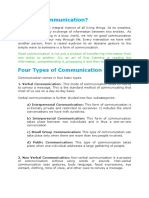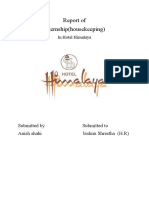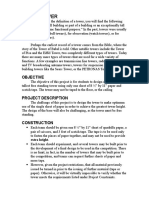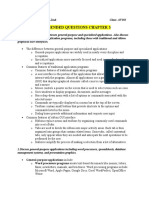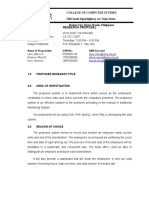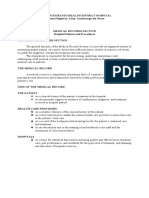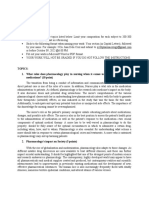Community Pharmacy.
Community Pharmacy.
Uploaded by
Iftikar hussainCopyright:
Available Formats
Community Pharmacy.
Community Pharmacy.
Uploaded by
Iftikar hussainOriginal Description:
Original Title
Copyright
Available Formats
Share this document
Did you find this document useful?
Is this content inappropriate?
Copyright:
Available Formats
Community Pharmacy.
Community Pharmacy.
Uploaded by
Iftikar hussainCopyright:
Available Formats
Community pharmacy
Definition : Community Pharmacy referred to retail pharmacy or retail drug outlets where medicines are stored and
dispenses, supplied or sold. Community pharmacy include those establishments that are privately owned and
whose function is to serve the society needs for both drug products and the pharmaceutical services.
• The main responsibilities of a community pharmacy include compounding, counseling, and dispensing of drugs
on prescription to the patients with care, accuracy, and legality along with proper procurement, storage,
dispensing and documentation of medicines.
• The community pharmacist should have the required education, skills, and competence to deliver professional
services.
• The community pharmacist should give detail about prescription and advise about home health care supplies.
Functions of Community Pharmacy:
• Providing health information to patient and public
• Administration of pharmacy
• Store, dispensing and documentation of medicine
• Compounding of medicine
• Provide drug information and their action
• Handling of prescriptions
• Patient counseling
• Patient medication record
• Involve in National health programme
• Rational drug therapy
ORGANIZATION AND STRUCTURE OF RETAIL AND WHOLESALE DRUG STORE
• Central Drug Standard Control Organization (CDSCO):- Headed by the Drugs Controller General (India) (DCGI)
which discharges the functions allocated to Central Government by the Drugs and Cosmetics Act.
• State Drugs Control Organizations:- The State Drugs Control Organization was set up in the state to implement
the provisions of the Drugs and Cosmetics Act, 1940 and its subsequent amendments.
• Manufacturing
• Wholesaler
• Retailer
• Consumer
Design of drug store (retail and wholesale drug store)
• A modern drug store should fulfill all the requirements in schedule N of the Drug and Cosmetic rule 1945.
• Minimum floor space required for a drug store
o Wholesale drug store: 200sqft
o Retail drug store: 150sqft
Site:
• Should be at the centre of the population to be served
• Ensure accessibility and convenience
• Equipped with adequate and free parking facility.
Objective of ideal layout design:
• To attract a large number of customers
• To increase the sales of the store
• To reduce the selling expenses to the minimum
• To provide customer satisfaction
• Have adequate space for reserve stock, office and resting space
• To have proper entrance for the newly arrived goods
• To project a professional image and improve general appearance
• To minimize the movement of the customers in the premises of the pharmacy
Types of a drug store: On the basis of design, it is classified as:
1. Traditional Drug Stores: These types of drug stores are designed in such a manner that the entire area of Drug
store is exposed to customers. Such a design has pleasing and professional appearance and is convenient for
both workers and customers. It provides opportunity for maximum sales but there are good chances of theft in
such design.
2. Personal Service Drug Stores: In this type of design, the whole of the area is not exposed to the customer but
the customer is required to interact with the drug store personnel at the service counter. During the purchasing
process the customer demands an article and the personnel provide the articles. This service and design
facilitates maximum interaction between drug store employee and the customers. The success of the drug store
depends upon the convenience and friendly service of the personnel at the service counter.
3. Prescription Oriented Drug Store: These types of drug stores provide a comfortable waiting area where the
customers are expected to wait while his prescription is proceeding. In this type of design health related items,
drugs and prescription accessories are displayed in the vicinity while orthopedic and surgical appliances are
kept in a separate room. Cosmetics and gifts are arranged in a suitable area in the store.
4. Pharmaceutical Centre: These types of centre sell medicines, convenience articles, orthopedic and surgical
appliances. The store has sufficient floor space and is properly decorated.
5. Super Drug store: Such types of drug stores have a huge floor area ranging from 5,000 to 10000 with a square
design. The customers have access to all-most-all the area in the drug store and can inspect, handle and select
articles themselves. The design is on self service pattern except for the prescription department where self
service is not possible.
Legal requirements for the establishment of retail drug store:
1) Licenses:
a). General Licenses:- Granted to person who have the premise for the business and a qualified person to
supervise the sale of the drugs and do the compounding sand dispensing.
The licenses for general sale of drugs are issued in
Form 20- The license for the retail sale of drugs excludes which are mentioned in the Schedule C, C1 and X
Form 21- For drugs specified in Schedule C and C1 and excluding X
Form 20F –for drugs specified in schedule X
Conditions for general licenses:-
1.The license should be displayed in prominent place in a part of premises open to the public.
2.The license should comply with the provision of drug and cosmetics act and rules.
3.Any change in the staff should be reported to the licensing authority within one month.
4.Precaution prescribed by the licensing authority for the storage of Schedule C and C1 should be observed.
5.For the sale of additional categories of drug listed in Schedule C1 C1 excluding X the license must take
prior permission of the license authority.
b). Restricted Licenses: Granted to dealers or person who deal in sale of drugs, which do not require the service
of qualified person.
The licenses for the restricted sale of drugs are issued in
Form 20A – for drugs other than those specified in Schedule C, C1 and X
Form 21A – for drug specified in Schedule C and C1 but not in X
No license is granted for schedule X drugs in this category
Conditions for restricted licenses:
1.Drug should be sold in their original container.
2.License should be complying with the provision of drugs and Cosmetics Acts and Rules.
3.Drug only purchased from a duly licensed dealer.
4.The licenser must have adequate premises equipped with facilities for the proper storage of drug.
2) Staff (Personnel): Personnel or staff selection is one of the most important aspects of developing an efficient
operating community pharmacy.
Success of a community pharmacy depends upon proper selection training, and maintenance of employees
(staff).
Selection of staff: Following criteria should be followed during the selection of the staff for community
pharmacy:
a. Should be a register pharmacist, having minimum qualification
b. Selection should be based on Job description, Job specification, Job recruitment based on test, interview etc
c. This job description should contain such detail as scope of job, its relation to other jobs, working hours, and
pay scale, etc. It prevents misunderstanding about the nature of the duties of a particular job.
d. Promotion within a pharmacy staff may be appropriate. But in most of the cases external source must be
used such as employment agencies, placement offices of schools and universities or classified news paper
advertising.
Orientation and training of staff: After proper selection needs to be followed by adequate orientation and
training of the employee, which results in increase productivity and reduced employee turnover.
Compensation: Retaining good employees is one of the most difficult problems faced by the community
pharmacy manger. Many factors decides keeping of employees but most important factor is the compensation
plan. Adequate compensation is necessary, not only to retain employee but also to encourage them to work
toward the over all goals and objectives of the pharmacy.
Maintenance of records:- 1). Legal records 2). Patient records 3). Financial records
Legal records: Required by law regarding the acquisition and disposition of drugs.
a. Pharmacy owner is responsible for maintenance of adequate and up to date records of drugs and poisons
as per Drugs and cosmetics act 1940, Rules 1945 and the Poison Act 1919.
b. Pharmacist should maintain record related to acquisition and disposition of certain drugs, poisonous and
hazardous substances.
c. Improper or incomplete maintained record may bring legal action or penalties
Patient records: Regarding the patient utilization of the drugs.
a. Patients drug history and amount of drugs taken by average patients.
b. Source of information on insurance claims and income tax deduction of patients.
Financial records: Regarding the past and present financial status
a. Analyzing revenues and expenses, for making sound decision regarding future needs, inventory
requirements, etc.
b. For evaluation of past operations, planning of present activities, forecasting needs, and controlling the
activities.
c. Measuring return on investment.
You might also like
- IM Categorical Programs 2024 Match CycleDocument11 pagesIM Categorical Programs 2024 Match Cycleqrw8dhwtgrNo ratings yet
- Classroom Activities: Contributor Materials Brief Description of ActivityDocument9 pagesClassroom Activities: Contributor Materials Brief Description of ActivityJefferson VilelaNo ratings yet
- SDLC With Waterfall ModelDocument5 pagesSDLC With Waterfall ModelVikalp PanseriyaNo ratings yet
- UNIT-I (D) - Community PharmacyDocument32 pagesUNIT-I (D) - Community Pharmacyrajeshwari ninaweNo ratings yet
- Pharmacy Layout Design: M.PHIL PHARMACEUTICS (2020-2022) 1 SemesterDocument11 pagesPharmacy Layout Design: M.PHIL PHARMACEUTICS (2020-2022) 1 SemesterArenly LongkumerNo ratings yet
- 1 - Principles of Good Customer ServiceDocument25 pages1 - Principles of Good Customer ServiceEMELIE GRACE E CACHERO100% (1)
- Barriers To CommunicationDocument4 pagesBarriers To CommunicationAbhimanyu SinghNo ratings yet
- Sops For Cleaning The Dining AreaDocument1 pageSops For Cleaning The Dining AreaAjaypal Singh RawatNo ratings yet
- Unit 201 Principles of Communication in Adult Social CareDocument3 pagesUnit 201 Principles of Communication in Adult Social Careamacovei_3No ratings yet
- AssignmentDocument5 pagesAssignmentJamesNo ratings yet
- Global SustainabilityDocument21 pagesGlobal Sustainabilityramszlai100% (1)
- UNIT 3 Lesson 2 Minutes of The MeetingDocument5 pagesUNIT 3 Lesson 2 Minutes of The MeetingAngelica TalandronNo ratings yet
- Concept of Mental Health - MKU-1Document35 pagesConcept of Mental Health - MKU-1Favour Joshua MpumurijeNo ratings yet
- Unit 74 Support Individuals With Specific Communication NeedsDocument10 pagesUnit 74 Support Individuals With Specific Communication NeedsEmma HarrisNo ratings yet
- CHAPTER 4 - Marketing PlanDocument30 pagesCHAPTER 4 - Marketing PlanMohd Faiz Ash BurnNo ratings yet
- Report of InternDocument8 pagesReport of InternAneesh ShahiNo ratings yet
- PHBP Prelims - ReviewerDocument39 pagesPHBP Prelims - ReviewerAia RohaNo ratings yet
- Orca Share Media1569579600307Document6 pagesOrca Share Media1569579600307Ronald AbletesNo ratings yet
- Research TopicsDocument15 pagesResearch TopicsmalinksNo ratings yet
- Unit 1-Lesson 4 - Market Need AnalysisDocument9 pagesUnit 1-Lesson 4 - Market Need AnalysisMarra Kathleen AyaayNo ratings yet
- Market Research and AnalysisDocument6 pagesMarket Research and AnalysishasanulfiqryNo ratings yet
- MEDICAL TRANSCRIPTION - IntroductionDocument9 pagesMEDICAL TRANSCRIPTION - IntroductionRDSNo ratings yet
- Mental Status Exam ERICDocument3 pagesMental Status Exam ERICDesiree AfagaNo ratings yet
- Oral Presentation in The WorkplaceDocument14 pagesOral Presentation in The WorkplaceRoyce IbuanNo ratings yet
- Notes On Restaurant Furniture and LinenDocument3 pagesNotes On Restaurant Furniture and Linennina.ariano.tan100% (1)
- Design Concept Note Template: Project InformationDocument2 pagesDesign Concept Note Template: Project Informationabbshey100% (1)
- Nursing InformaticsDocument14 pagesNursing InformaticsAve Meri Noreen PizonNo ratings yet
- Best Wishes Card Templates: Blue Best Friend Happ Weddin Con Ratulations Greetin Gift CardDocument1 pageBest Wishes Card Templates: Blue Best Friend Happ Weddin Con Ratulations Greetin Gift CardSyarifah SalmiahNo ratings yet
- What Is Mental Illness: Mental Illness Facts: Home Inform YourselfDocument1 pageWhat Is Mental Illness: Mental Illness Facts: Home Inform YourselfannamariaaaantonatouNo ratings yet
- 4.1 Applied Productivity Tools Using Word Processor: I. Learning Skills A. Learning CompetencyDocument4 pages4.1 Applied Productivity Tools Using Word Processor: I. Learning Skills A. Learning CompetencyYvone Mae Mayor-RevaleNo ratings yet
- Qualitative MethodsDocument30 pagesQualitative MethodsBhaskar RoyNo ratings yet
- Mls 050 NotesDocument24 pagesMls 050 NotesJulianneNo ratings yet
- Paper TowerDocument2 pagesPaper TowerprincetonymesNo ratings yet
- Reaction Paper On Food Inc.Document1 pageReaction Paper On Food Inc.Gabrielle Albertha C. Burgos25% (4)
- Lesson 3 - Assignment - Create PersonasDocument2 pagesLesson 3 - Assignment - Create PersonasGarcia Raph100% (1)
- Health and Wellness MODULE 2Document26 pagesHealth and Wellness MODULE 2Albert Fabros GapasinNo ratings yet
- Arciga - IT0021 - Laboratory Exercise 1-1Document7 pagesArciga - IT0021 - Laboratory Exercise 1-1Sage ArcigaNo ratings yet
- Documenting Reporting X Medication IIDocument12 pagesDocumenting Reporting X Medication IIRowena SamsonNo ratings yet
- Applied Business Tools and Technologies in TourismDocument9 pagesApplied Business Tools and Technologies in TourismLUISA MARIE DELA CRUZNo ratings yet
- Marber National High SchoolDocument4 pagesMarber National High Schoolbonifacio gianga jr100% (1)
- Open-Ended Questions Chapter 3Document3 pagesOpen-Ended Questions Chapter 3Nguyễn Khánh LinhNo ratings yet
- Sample Title ProposalDocument5 pagesSample Title ProposalBrent Espinosa100% (1)
- TechnopreneurshipDocument13 pagesTechnopreneurshipKhalinux AnonimoNo ratings yet
- Research VincentDocument38 pagesResearch VincentMaryrose Aguirre SerranoNo ratings yet
- Prevention of Disease & Health PromotionDocument2 pagesPrevention of Disease & Health PromotionGhith WhiuNo ratings yet
- Computer 9: Web DesignDocument5 pagesComputer 9: Web DesignNovelyn Kaye Ramos Calanoga100% (1)
- Study Cards Chapter 1 Terms - Mental Health and Mental IllnessDocument12 pagesStudy Cards Chapter 1 Terms - Mental Health and Mental IllnessJilian McGuganNo ratings yet
- 3 Techniques Needs in Technical WritingDocument8 pages3 Techniques Needs in Technical WritinghezekeahNo ratings yet
- Per - Devt. TG Shs v.1Document226 pagesPer - Devt. TG Shs v.1Kimverly GurreaNo ratings yet
- District Sales Manager, Sales Director, Director of OperationsDocument3 pagesDistrict Sales Manager, Sales Director, Director of Operationsapi-78369867No ratings yet
- Baking Equipments and Their UsesDocument38 pagesBaking Equipments and Their UsesWilkendrick CallanganNo ratings yet
- Characteristics of Technical WritingDocument2 pagesCharacteristics of Technical Writingwaqarali78692100% (1)
- Biostatistics in RTDocument2 pagesBiostatistics in RTJA KENo ratings yet
- Chapter 5Document30 pagesChapter 5Arlene LagcoNo ratings yet
- Pharmaceutical Biochemistry PDFDocument4 pagesPharmaceutical Biochemistry PDFvinay0717No ratings yet
- Introduction To Spreadsheets: Information TechnologyDocument38 pagesIntroduction To Spreadsheets: Information TechnologyTehseen BalochNo ratings yet
- Mental and Emotional HealthDocument2 pagesMental and Emotional HealthEden LacsonNo ratings yet
- Creating BrochuresDocument20 pagesCreating BrochuresAnthonyNo ratings yet
- CHS-NC2 Reviewer - With Oral Questioning - 0Document24 pagesCHS-NC2 Reviewer - With Oral Questioning - 0Tushiro K. Himura100% (1)
- Community PharmacyDocument8 pagesCommunity PharmacyAmit KumarNo ratings yet
- Community Pharmacy Layout Full ChapterDocument4 pagesCommunity Pharmacy Layout Full ChaptersaleemNo ratings yet
- AlisonwebsterresumeDocument2 pagesAlisonwebsterresumeapi-652403711No ratings yet
- Child Survival Action Plan - Sierra Leone 2023-2025Document36 pagesChild Survival Action Plan - Sierra Leone 2023-2025Saurav AmanNo ratings yet
- Final of Hospital Accreditation SATDocument1,879 pagesFinal of Hospital Accreditation SATalyaa aliNo ratings yet
- 993-Article Text-4235-1-10-20220723Document10 pages993-Article Text-4235-1-10-20220723Diana DaviscaNo ratings yet
- Acf Advert FinalDocument4 pagesAcf Advert FinalOscar Zhen Yu WongNo ratings yet
- Ezeorah Perpetua Chidiebere - CVDocument4 pagesEzeorah Perpetua Chidiebere - CV200electronicmailNo ratings yet
- Nursing As A ProfessionDocument3 pagesNursing As A ProfessionEsthermae PanadenNo ratings yet
- BMC Pregnancy & ChildbirthDocument13 pagesBMC Pregnancy & ChildbirthZen ShuziNo ratings yet
- Komal Jat InternshipDocument10 pagesKomal Jat Internshipvinit PatidarNo ratings yet
- Sample Interview QuestionsDocument2 pagesSample Interview QuestionsTin BabistaNo ratings yet
- Tentative Amu Central Seat Matrix For MD - MS - DiplomDocument5 pagesTentative Amu Central Seat Matrix For MD - MS - DiplomSurya NarayanaNo ratings yet
- CBH Template Root Cause Analysis 2021 09Document5 pagesCBH Template Root Cause Analysis 2021 09renuNo ratings yet
- VNNhos 8 RMVIHv T6 J CQZM 9 S Vajk PQF TXIdykq L36 QDocument4 pagesVNNhos 8 RMVIHv T6 J CQZM 9 S Vajk PQF TXIdykq L36 Qmikaela perezNo ratings yet
- RA-044744 ARCHITECT Cebu 1-2023Document21 pagesRA-044744 ARCHITECT Cebu 1-2023Jaed LouiseNo ratings yet
- NURS-FPX4020 - JohanneDesiree - Assessment1-1Document7 pagesNURS-FPX4020 - JohanneDesiree - Assessment1-1Esteban García EcheverryNo ratings yet
- KLE Pharmacy - NPC Brochure 2022Document13 pagesKLE Pharmacy - NPC Brochure 2022Bhaskar PandeyNo ratings yet
- dc2021-0274 Hospital HIM Manual 4th EditionDocument1 pagedc2021-0274 Hospital HIM Manual 4th EditionHealth Facility Development UnitNo ratings yet
- LILOY INTEGRATED HEALTH DISTRICT HOSPITAL - MarlynDocument7 pagesLILOY INTEGRATED HEALTH DISTRICT HOSPITAL - Marlynmarlyn donioNo ratings yet
- Weebly Resume of Alyssa GonzalezDocument2 pagesWeebly Resume of Alyssa Gonzalezapi-738741178No ratings yet
- Notebook Work ROLE OF GOVT IN HEALTH-2023-24Document3 pagesNotebook Work ROLE OF GOVT IN HEALTH-2023-24Divyanshi BansalNo ratings yet
- Dr. Chandra Sekhar Dannana Best Orthopaedic Surgeon in Hyderabad CARE Hospitals Outpatient Centre Banjara Hills - Google LocDocument1 pageDr. Chandra Sekhar Dannana Best Orthopaedic Surgeon in Hyderabad CARE Hospitals Outpatient Centre Banjara Hills - Google Lockundan kumarNo ratings yet
- No.5 - Methods-Of-Patient-AssignmentDocument7 pagesNo.5 - Methods-Of-Patient-AssignmentPawan BatthNo ratings yet
- KAILADocument3 pagesKAILAShareeze Ann GomezNo ratings yet
- Family Medicine-Scope, Role, and FunctionDocument4 pagesFamily Medicine-Scope, Role, and FunctionMonsour SalazarNo ratings yet
- Levels of CareDocument3 pagesLevels of CareLi mNo ratings yet
- AHF Sierra Leone EOI For Engineering Firms - 2021 (LC Comments)Document3 pagesAHF Sierra Leone EOI For Engineering Firms - 2021 (LC Comments)Samuel WilliamsNo ratings yet
- Reviewing Achievements and Obstacles in Nepal's National Health Insurance ProgramDocument10 pagesReviewing Achievements and Obstacles in Nepal's National Health Insurance ProgramInternational Journal of Innovative Science and Research TechnologyNo ratings yet
- Provider QLD by Name 20210329 0Document473 pagesProvider QLD by Name 20210329 04ptr69tscyNo ratings yet
- Patient Engagement and Safety - PSNetDocument5 pagesPatient Engagement and Safety - PSNetanithaNo ratings yet






